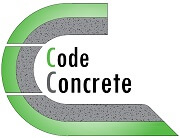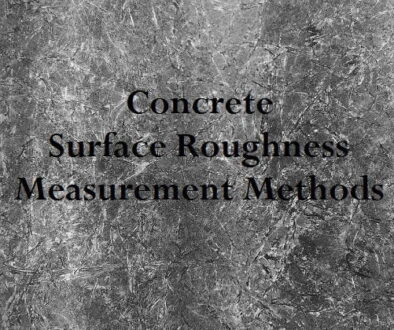The Ultimate Crash Course to Concrete Surface Preparation
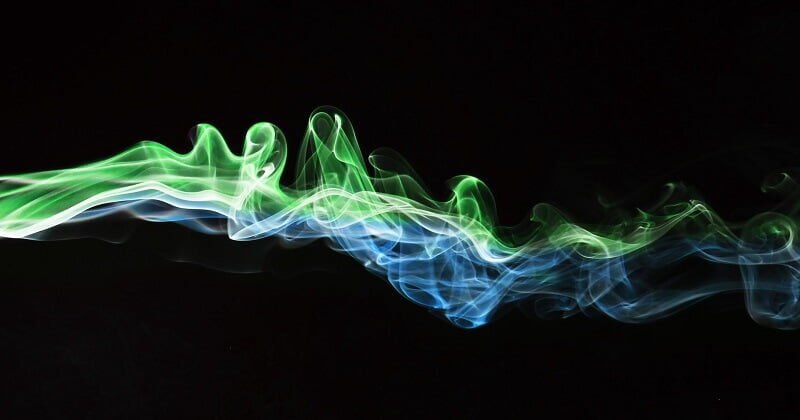
Last updated on February 14th, 2022
What is concrete surface preparation?
Concrete surface preparation is basically the process of creating a suitable surface for repairs or protective layers. That is to say, a suitable surface is one that is mainly sound, clean, and having the adequate profile to ensure a proper adhesion, bond, and/or penetration of the following material. In fact, the preparation procedure depends on three factors:
- The initial substrate conditions.
- Workplace conditions.
- And type of layer to be installed.
Hence, the actual process can vary between a project and another. But in general, a typical surface preparation procedure includes the following five steps:
- Performing pre-surface-preparation inspections.
- Decisions and tasks based on the initial inspections.
- Profiling the surface to the suitable level of roughness.
- Cleaning it from any undesired substances.
- Performing post surface-preparation inspections.
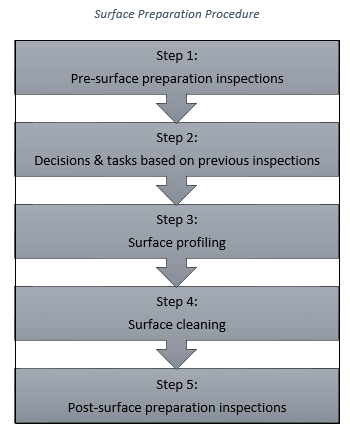
In fact, each step of this general procedure is a huge topic by itself. However, we will explain the major aspects of each in a concise manner.
1. Pre-surface-preparation inspections
Pre-surface-preparation inspections can help in assessing the conditions of the substrate and the job-site, which are two of the three main factors in determining the adequate surface preparation method(s).
Determining the substrate conditions
Determining the initial conditions of the substrate is an essential part of the inspection process. Basically, this step involves checking numerous factors or parameters, such as surface problems, contamination, type of finish, moisture, and others. In fact, this step is crucial for characterizing the amount of preparation required.
For more detailed information about this subtopic, you can check ICRI’s checklist for the evaluation of substrate conditions, by referring to ICRI 310.2R Appendix A Section 1. In addition, you can check NACE No. 6/SSPC-SP 13 Section 3 which also addresses some of the important considerations.
Determining the job-site conditions
Likewise, determining the job-site conditions is also important, since it can influence the selection of the surface preparation method(s). Mainly, this step involves assessing factors such as the location, restrictions (time, noise, vibration, etc.) exposure, environmental aspects, power, and others.
For additional information, you can refer to ICRI’s jobsite conditions evaluation tree, or checklist, in ICRI 310.2R Appendix A section 3.
2. Decisions and tasks based on initial inspections
Based on the assessment and evaluation of pre-surface-preparation inspections, some work may be required before profiling the surface. To illustrate, these may include the removal of some concrete, removal of old protective layers, repairs, treatments, and cleaning. Specifically, all unsound concrete should be removed and replaced. Also, any type of existing protective layers that can negatively affect the adhesion, penetration, or bond of the new protective layer should be removed. In addition, repairs should be done at this stage. For example, problems such as cracks, spalling, corrosion, and honeycombs require repairs. Furthermore, in case of a chemical contamination, the surface should be properly tested, treated, and/or cleaned.
3. Concrete surface profiling
Surface profiling is the process of opening the pore structure and roughening the texture to the desired level, where the surface profile resembles its degree of roughness.
Based on this definition, the topic boils into three major questions:
- i. First, how to measure the profile of a surface or its degree of roughness?
- ii. Second, how to determine the required surface profile for a certain application?
- iii. And third, how to achieve the required profile?
But before we address these questions, it is important to note that the necessary degree of roughness may vary depending mainly on the type of the protective layer to be installed.
i. How to measure the profile of a surface or its degree of roughness?
In general, there are several methods to measure the profile of a surface. These can be mainly categorized into qualitative and quantitative methods.
On one hand, qualitative ones are those which are visual and/or tactual. In general, they involve the use of certain comparators (e.g. ICRI’s CSP ships) to determine the surface profile.
On the other hand, quantitative methods are those that measure topographical parameters and give scientific values. They mostly include the use of profilometers, or surface profile measuring instruments, in order to quantify the surface roughness.
You can find additional information on how to measure the profile of a surface, the different methods, and the standards and guidelines that address this topic in the following article, “7 Concrete Surface Roughness Measurement Methods“.
ii. How to determine the required surface profile for a certain application?
The surface profile requirements mainly depend on the type of the protective layer to be installed. Generally, thicker protective layers require rougher surfaces. In fact, one of the most practical guidelines to refer to when addressing this subtopic is the ICRI 310.2R. This guideline illustrates the suitable surface profiles, according to their identification, for different protective layers. For instance, sealers (0 to 75 micrometers thick) require a CSP between 0 and 2. Whereas, other types of resin floors require different CSP ranges. Besides, it is important to note that some manufacturers of such products specify the CSP requirement range for their specific products based on testing.
iii. How to achieve the required profile?
To achieve the surface profile requirements, it is important to prepare it through a suitable method. ICRI 310.2R provides a table with the approximate CSP ranges that can be achieved with different preparation methods. For example, acid etching would give a CSP between 0 and 3. However, it is important to note that this is only an approximation. In fact, the actual CSP result can vary depending on other factors such as the properties of concrete.
Concrete surface preparation methods
Concrete surface preparation methods are the means to achieve the required CSP. These include scrubbing, low pressure water cleaning, grinding, etching, needle scaling, abrasive blasting, shot-blasting, high pressure water jetting, scarifying, using a surface retarder on fresh concrete, roto-milling, scabbling, and using handheld concrete breakers.
How to determine which method is most suitable for a certain application?
Choosing the ideal method for a specific project requires assessing or considering three main factors, the initial substrate conditions, the job-site conditions, and the required CSP which is directly related to the material.
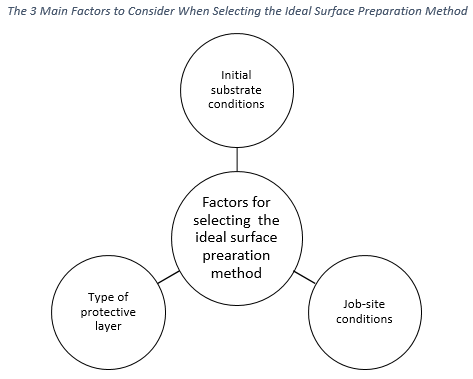
We addressed these three factors previously in this article. Accordingly, the ideal profiling method should meet the requirements of these factors.
4. Surface cleaning
Surface cleaning is an important process to remove any material that can affect the adhesion, bond, or penetration of the protective layer or repair material to the concrete surface. To illustrate, these materials include dust, contaminants, debris, dirt, loose laitance, oil, and grease.
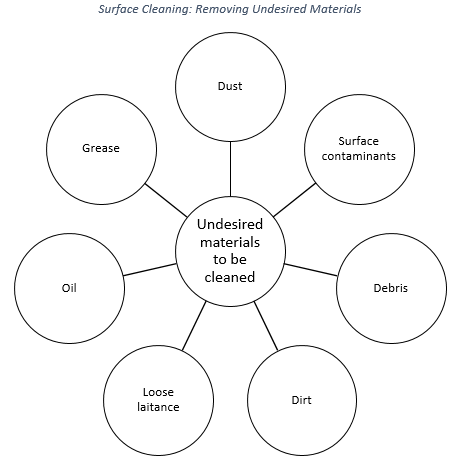
Surface cleaning methods
There are various cleaning methods that can remove different undesired materials. These include broom cleaning, vacuum cleaning, air blasting, water cleaning, detergent cleaning, and steam cleaning. For more information about cleaning concrete surfaces, you can refer to ASTM D4258.

5. Post surface-preparation inspections
Post preparation inspections are essential to evaluate the suitability of the prepared surface. Basically, the surface is examined visually and through testing to ensure its readiness for the application of the protective layer. In fact, these tests mainly evaluate the tensile bond strength, adhesion, surface pH, surface profile, cleanliness, moisture content, absorption, delamination, bruising and micro-cracks.
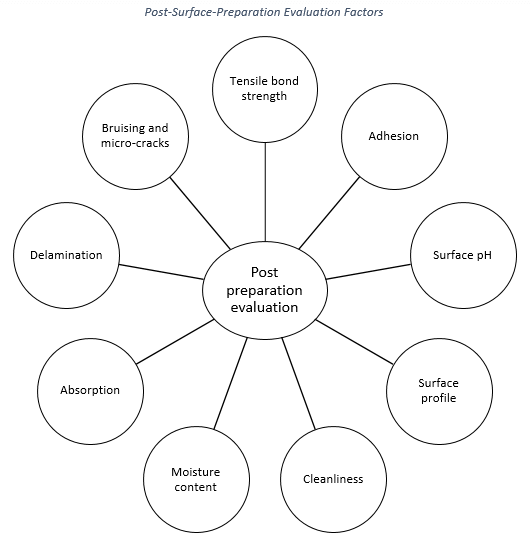
These are only the main evaluation factors to consider for post-preparation inspection and testing. For more information about the tests and standards to determine these parameters, you can refer to ICRI 310.2R Appendix B and NACE No. 6/SSPC-SP 13 Section 5 and Section 6.
Conclusion
Concrete surface preparation is an essential process when it comes to applications such as repairs and protective treatments. Its fundamental role is to create a surface which is sound, clean, and having the adequate profile for a proper adhesion, bond, and/or penetration of the following material.
Bibliography
- ICRI Committee. (2013). ICRI 310.2R Selecting and Specifying Concrete Surface Preparation for Sealers, Coatings, Polymer Overlays, and Concrete Repair. International Concrete Repair Institute.
- NACE International, & SSPC Group Committee. (2003). Joint Surface Preparation Standard NACE No. 6/SSPC-SP 13 Surface Preparation of Concrete. Houston TX, and Pittsburgh PA: NACE International and SSPC: The Society for Protective Coatings.
